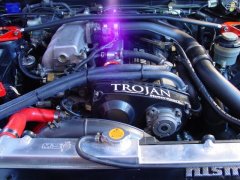Came Back From My Holiday Today
Announcements
-
Similar Content
-
Latest Posts
-
I agree on doing some better than factory pistons, rods, and oil pump. For anyone using the vehicle on the road, I don't get why everyone wants big cams. The stock cam profile, with some more lift would be mint for road usage. Everyone going big cams and then wondering why it isn't as responsive in traffic, when they've shifted the torque curve upwards an additional 1000RPM. Make torque, at lower RPM. Sure it's not as cool as claiming "500KW" and revving it to 8,0000RPM, but that same torque 2,000RPM earlier... Then you don't need the extremely high end pistons and rods, and blah blah blah.
-
Personal experience. Those f**kers burn. And are actually a PITA to put out. Next time I walk down the back, I'll snap a photo of what the inside of the bonnet looks like when that thing ignites. PS, powder fire extinguishers are useless on that stuff too as it's fibrous and when it ignites, it starts to pull apart. And you end up just blowing powder through a sieve effectively. Like the big thing is, if it's fire resistant, it's job is to stop what burning? The METAL above it? It's just to try keep heat off the bonnet paint work.
-
That's more or less what he meant. What it really means is that you do not have to go full crazy on the build. Don't need the best oil pump, expensive rods & pistons, big cams, etc. You can upgrade whatever you want instead of using stock level items, but you don't have to. Having said that - any time an RB is opened up, if anything is getting replaced, I think the opportunity should be taken to do all the sensible upgrades. Pistons, rods, pump, etc.
-
February update 🙂 We managed to get the very last 1/18th "Extra Scale" cars stock available from bookstores in Kyoto. These are actually the last ones and will not be restocked again! Hachette Collections Japan have not decided on a release date for these or other models in the series, so for the time being these are all there are available new. These are showing up on Yahoo auctions at inflated prices already (especially the Celica and NSX) so get yours now at a very reasonable price before they disappear! Stock quantities: NA1 Honda NSX - 1 left: https://www.oemsoko.co.jp/products/1-18-extra-scale-1990-na1-honda-nsx 1973 Toyota Celica LB 2000GT - 2 left: https://www.oemsoko.co.jp/products/1-18-extra-scale-1973-toyota-celica-lb-2000gt 1968 Mazda Cosmo Sport - 2 left: https://www.oemsoko.co.jp/products/1-18-extra-scale-1968-mazda-cosmo-sport 1970 KPGC10 Nissan Skyline 2000GT-R - 2 left: https://www.oemsoko.co.jp/products/1-18-extra-scale-1970-kpgc10-nissan-skyline-2000gt-r
-








Recommended Posts
Create an account or sign in to comment
You need to be a member in order to leave a comment
Create an account
Sign up for a new account in our community. It's easy!
Register a new accountSign in
Already have an account? Sign in here.
Sign In Now